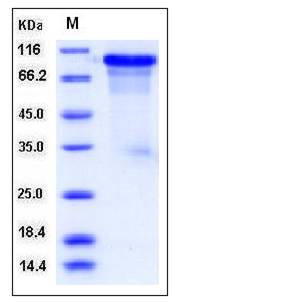Mouse ECM1 Protein (His Tag)
AI663821,p85
- 100ug (NPP2716) Please inquiry
| Catalog Number | P50331-M08H |
|---|---|
| Organism Species | Mouse |
| Host | Human Cells |
| Synonyms | AI663821,p85 |
| Molecular Weight | The secreted recombinant mouse ECM1 comprises 551 amino acids and has a predicted molecular mass of 62.5 kDa. As a result of glycosylation, the apparent molecular mass of rm ECM1 is approximately 90-95 kDa in SDS-PAGE under reducing conditions. |
| predicted N | Ala 20 |
| SDS-PAGE |  |
| Purity | > 88 % as determined by SDS-PAGE |
| Protein Construction | A DNA sequence encoding the mouse ECM1 isoform 1 (Q61508-1) (Met 1-Glu 559) was expressed, fused with a polyhistidine tag at the C-terminus. |
| Bio-activity | Measured by its ability to bind human MMP-9 in a functional ELISA. |
| Research Area | Cardiovascular |Lipids / Lipoproteins |Lipid Metabolism |Cytochromes |
| Formulation | Lyophilized from sterile PBS, pH 7.4 1. Normally 5 % - 8 % trehalose, mannitol and 0.01% Tween80 are added as protectants before lyophilization. Specific concentrations are included in the hardcopy of COA. |
| Background | Extracellular matrix protein 1 (ECM1) is a secreted glycoprotein and playing a pivotal role in endochondral bone formation, angiogenesis, and tumour biology. Three splice variants have been identified: ECM1a (540 aa) is most widely expressed, with highest expression in the placenta and heart; ECM1b (415 aa) is differentiation-dependent expressed and found only in tonsil and associated with suprabasal keratinocytes; ECM1c (559 aa) accounts for approximately 15% of skin ECM1. Although ECM1 is not tumor specific, is significantly elevated in many malignant epithelial tumors and is suggested as a possible trigger for angiogenesis, tumor progression and malignancies. It also has been shown to regulate endochondral bone formation, skeletal development and tissue remodeling. |
| Reference |
